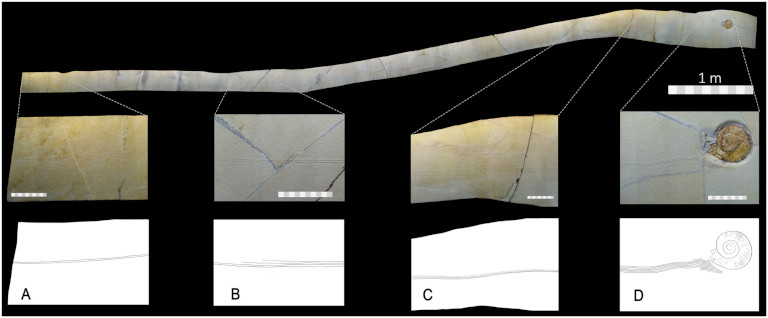Longest recorded fossil drag mark
A remarkable drag mark, 8.5 m (28 ft) long, has been located in the renowned Solnhofen Limestone deposit, Germany.1 The drag mark belongs to an ammonite, Subplanites rueppellianus, which was located embedded in the limestone at the end of this trace fossil. Ammonites are extinct squid-like creatures with a characteristic spiral chambered shell.

Trace fossils previously located in the limestone at Solnhofen include those of a horseshoe crab,2 crustaceans, and fish. The largely straight drag mark consists of parallel ridges with a single furrow, but a number of times additional ridges can be observed, created by the ‘ribs’ of the ammonite’s shell. The drag marks appear to have been made by the ammonite as it was carried along by a shallow wave making contact with the fresh sediment surface before coming to rest.

The paper’s authors think the ammonite was already dead, as it was missing the aptychus (a part of its body thought by many to be a jaw-piece). If they are correct then this “… represents the hitherto longest fossil drag mark created by a dead animal, complete with the animal preserved at the end”.1 Such a drag mark would not wait for any great period of time before being eroded away, and would need to have been covered by rapid sedimentation to be preserved. Solnhofen, known also for the fossils of the famous Archaeopteryx, has revealed a number of other breathtaking fossils that similarly do not fit with a millions-of-years framework and slow deposition.3
Dean Lomax, University of Manchester, who led the research, declared, “The fossil is perhaps one of the most unlikely of fossils to have ever been preserved, let alone be discovered”, adding that it “provides a snapshot of a moment that is captured in time—it really tells a story.”4 Yes, but that story is not one of millions of years, rather it is the historical account of Noah’s Flood found in Genesis 6–9, which would have provided ready mechanisms for rapid burials such as this one.
References and notes
- Lomax D., Falkingham P., Schweigert G., and Jiménez A., An 8.5 m long ammonite drag mark from the Upper Jurassic Solnhofen Lithographic Limestones, Germany, PLoS ONE 12(5):e0175426 2017 | doi:10.1371/journal.pone.0175426. Return to text.
- Walker, T., Death March: Horseshoe Crab stopped in its tracks, Creation 25(2):54–55, 2003; creation.com/death-march. Return to text.
- See for example: Robinson, P., Three become one, two fish and a pterosaur locked in a fatal struggle, Creation 37(4):38–39, 2015; creation.com/3fossils. Return to text.
- Briggs, H., Rare ammonite ‘death drag’ fossil discovered, bbc.co.uk/news, 8 May 2017. Return to text.






Readers’ comments
Comments are automatically closed 14 days after publication.